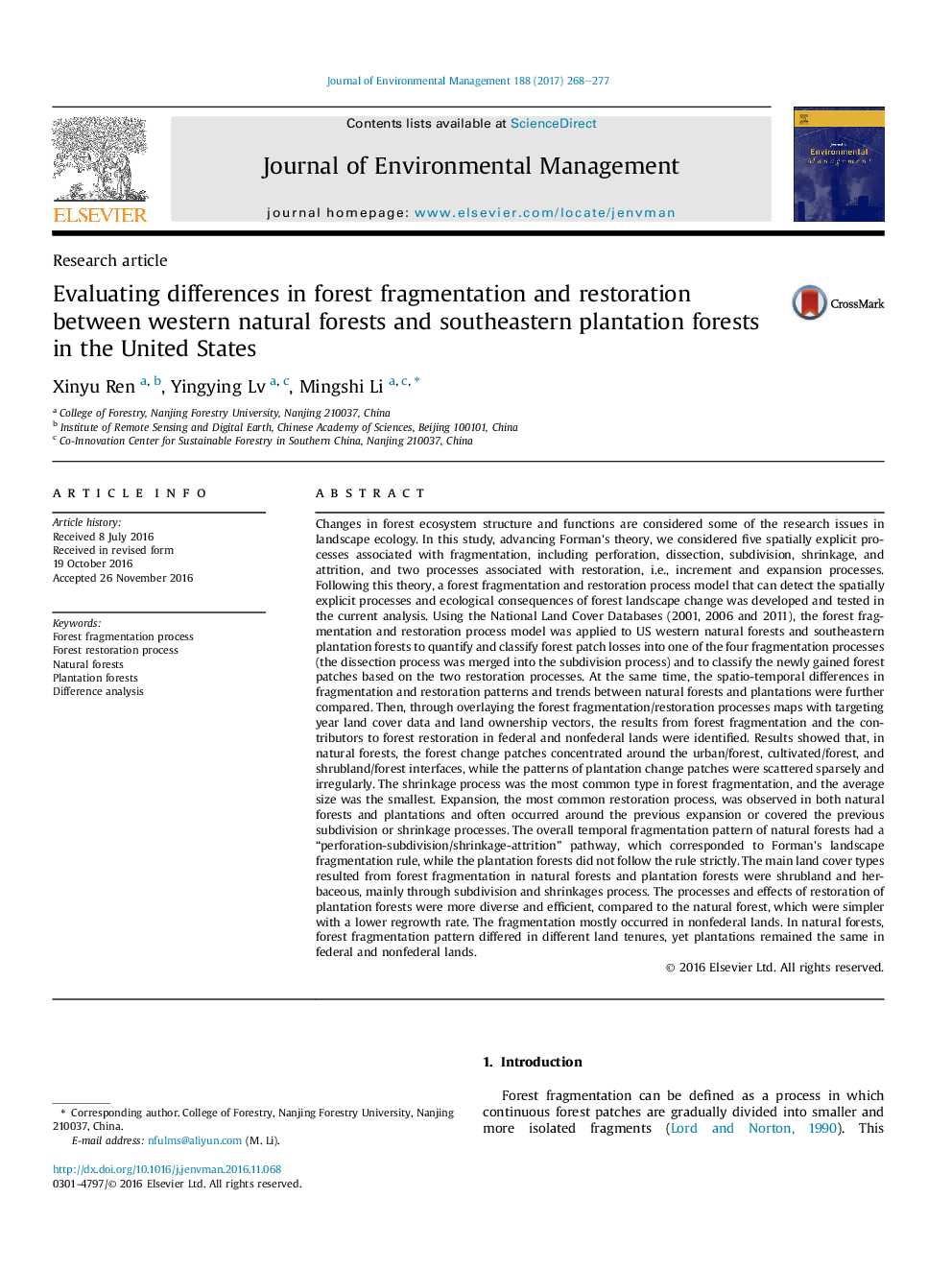| کد مقاله | کد نشریه | سال انتشار | مقاله انگلیسی | نسخه تمام متن |
|---|---|---|---|---|
| 5117144 | 1485227 | 2017 | 10 صفحه PDF | دانلود رایگان |
عنوان انگلیسی مقاله ISI
Evaluating differences in forest fragmentation and restoration between western natural forests and southeastern plantation forests in the United States
ترجمه فارسی عنوان
ارزیابی تفاوت های موجود در تقسیم و بازسازی جنگل بین جنگل های طبیعی غربی و جنگل های جنوب شرقی کاشت در ایالات متحده
دانلود مقاله + سفارش ترجمه
دانلود مقاله ISI انگلیسی
رایگان برای ایرانیان
کلمات کلیدی
روند تکه تکه شدن جنگل، روند ترمیم جنگل، جنگل های طبیعی جنگل های گیاهی تجزیه و تحلیل اختلاف،
موضوعات مرتبط
مهندسی و علوم پایه
مهندسی انرژی
انرژی های تجدید پذیر، توسعه پایدار و محیط زیست
چکیده انگلیسی
Changes in forest ecosystem structure and functions are considered some of the research issues in landscape ecology. In this study, advancing Forman's theory, we considered five spatially explicit processes associated with fragmentation, including perforation, dissection, subdivision, shrinkage, and attrition, and two processes associated with restoration, i.e., increment and expansion processes. Following this theory, a forest fragmentation and restoration process model that can detect the spatially explicit processes and ecological consequences of forest landscape change was developed and tested in the current analysis. Using the National Land Cover Databases (2001, 2006 and 2011), the forest fragmentation and restoration process model was applied to US western natural forests and southeastern plantation forests to quantify and classify forest patch losses into one of the four fragmentation processes (the dissection process was merged into the subdivision process) and to classify the newly gained forest patches based on the two restoration processes. At the same time, the spatio-temporal differences in fragmentation and restoration patterns and trends between natural forests and plantations were further compared. Then, through overlaying the forest fragmentation/restoration processes maps with targeting year land cover data and land ownership vectors, the results from forest fragmentation and the contributors to forest restoration in federal and nonfederal lands were identified. Results showed that, in natural forests, the forest change patches concentrated around the urban/forest, cultivated/forest, and shrubland/forest interfaces, while the patterns of plantation change patches were scattered sparsely and irregularly. The shrinkage process was the most common type in forest fragmentation, and the average size was the smallest. Expansion, the most common restoration process, was observed in both natural forests and plantations and often occurred around the previous expansion or covered the previous subdivision or shrinkage processes. The overall temporal fragmentation pattern of natural forests had a “perforation-subdivision/shrinkage-attrition” pathway, which corresponded to Forman's landscape fragmentation rule, while the plantation forests did not follow the rule strictly. The main land cover types resulted from forest fragmentation in natural forests and plantation forests were shrubland and herbaceous, mainly through subdivision and shrinkages process. The processes and effects of restoration of plantation forests were more diverse and efficient, compared to the natural forest, which were simpler with a lower regrowth rate. The fragmentation mostly occurred in nonfederal lands. In natural forests, forest fragmentation pattern differed in different land tenures, yet plantations remained the same in federal and nonfederal lands.
ناشر
Database: Elsevier - ScienceDirect (ساینس دایرکت)
Journal: Journal of Environmental Management - Volume 188, 1 March 2017, Pages 268-277
Journal: Journal of Environmental Management - Volume 188, 1 March 2017, Pages 268-277
نویسندگان
Xinyu Ren, Yingying Lv, Mingshi Li,
